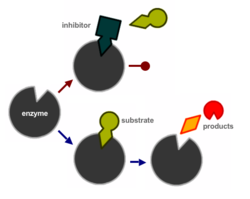PCR inhibitors: Difference between revisions
From OpenWetWare
Jump to navigationJump to search
No edit summary |
|||
| Line 1: | Line 1: | ||
[[Image:Inhibitor schematic.png|right|250px]] | [[Image:Inhibitor schematic.png|right|250px|thumb|Schematic of competitive inhibition of an enzyme. Note that active site inhibition is only one of many reasons why a PCR may not work.]] | ||
Many compounds also contained in the PCR template beside the target DNA can interfere with the polymerisation of nucleotides by the Taq or a related polymerase. This may result in false negative results, i.e. no PCR product even though the template is present. | Many compounds also contained in the PCR template beside the target DNA can interfere with the polymerisation of nucleotides by the Taq or a related polymerase. This may result in false negative results, i.e. no PCR product even though the template is present. | ||
| Line 24: | Line 24: | ||
== See also == | == See also == | ||
* [[Polymerase chain reaction inhibitors|PCR inhibitor at the Wikipedia]] | |||
* [[Maheshri:PCR]] - has some tips on how to avoid inhibition | * [[Maheshri:PCR]] - has some tips on how to avoid inhibition | ||
Revision as of 05:20, 7 July 2010

Many compounds also contained in the PCR template beside the target DNA can interfere with the polymerisation of nucleotides by the Taq or a related polymerase. This may result in false negative results, i.e. no PCR product even though the template is present.
Inhibitors from the purification process
- alcohols like ethanol and 2-propanol (isopropanol) from DNA template precipitation (Qiagen test of sequencing inhibition by Welters et al. 1997)
- organic solvents like phenol from phenol/chloroform purification (PMID 8136148)
- salts like KCl, NaCl from precipitation
- detergents like SDS,.. from membrane lysis (PMID 2223070)
Inhibitors from the source tissue
- components of blood: heme, hemoglobin, lactoferrin, immunoglobin G (IgG)
- liver, digestive tract, feces: bile salts, polysaccharides
- connective tissue, skin: collagen, melanin
- urine: urea
See Rådström et al. 2004 (PMID 14764939) for a review on how to avoid inhibition from tissue components.
Template inhibition
Since inhibitors often enter the PCR reaction via the template preparation, decreasing template volume may improve PCR results indirectly by reducing the quantity of inhibitors.
See also
- PCR inhibitor at the Wikipedia
- Maheshri:PCR - has some tips on how to avoid inhibition
- PCR - general, simple overview of polymerase chain reaction
- PCR techniques - hub page for PCR-based techniques
- Purification of DNA